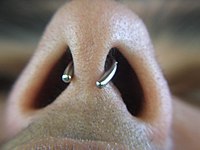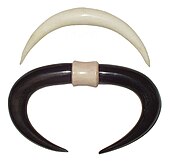Septum piercing
| Septum piercing | |
|---|---|

|
|
| location | Cuticle between cartilage and nasal septum |
| Jewellery | Ball Closure Ring, Septum Keeper, Circular Barbell Jewelry Note |
| Healing time | 2 to 3 months note on healing time |
| ‣ Topic overview | |
A septum piercing is a piercing through the connective tissue below the nasal septum cartilage . The name is derived from the Latin term for this: Septum nasi . It is one of the oldest piercings and is traditionally represented in many cultures around the world.
History and culture
The septum piercing is traditionally one of the most widespread piercings right after the ear piercing and is also found in far more cultures than the nostril piercing . It was often worn by warriors of various tribal societies and stung as part of initiation rituals.
Africa
The men of the Turkana and the Pokot , peoples in the northeast of Kenya , wore pendants made partly of aluminum with detailed embossing in the form of leaves in the septum. The same jewelry was used on the upper ear of Turkana women.
Women of the former nomadic people of the Fulbe , who have now settled in many countries, wear gold rings in the septum as a sign of wealth in addition to ear, neck and foot jewelry, whose ornaments are mostly reminiscent of plants or animals.
Asia

A stele of the Assyrian king Assurhaddon from 672 BC. BC from Zincirli shows how Assurhaddon holds the tiny kings of Tire and Egypt on ropes that are attached to the nose rings of the subjugated. This hardly represents a real process, but is supposed to show the slave-like dependence of the vassals.
Piercing in the nasal septum is also widespread in India , Sikkim , Nepal and Tibet , with sometimes considerably large pieces of jewelry. There are also oversized jewelry rings, so-called "bulaks", which extend over the mouth area.
America
Septum piercings were already widespread among the Aztecs , Maya and Inca , who used various pieces of jewelery made of jade or gold for religious reasons . This tradition is partly continued today by the Kuna in Panama .
In North America , septum piercings were worn by both male and female members of various Indian tribes such as the Haida or the Tlingit , where labret piercings were also common.
The Nez Perce ( franz. "Pierced nose"), an Indian -Volk of the Columbia River Plateau of the Pacific Northwest of the United States , were the reports Lewis and Clark Expedition of 1805 as Chopunnish called - an adaptation of the term cú · pʼnitpeľu ("The pierced people", derived from cú · pʼnit " piercing with a pointed object" and peľu "people"). However, since they did not wear any nose piercings or other jewelry, the name "pierced noses" was an inappropriateness and probably due to a confusion with the Chinook living on the lower reaches of the Columbia River , who shared fishing grounds and trading places with the Nez Percé.
The Shawnee , Tenskwatawa and Tecumseh chiefs also wore corresponding nose rings.
The women of the Aleutians attached pearl necklaces to the septal canal, which they let hang down over their chins. The chains were made of shells , coral or amber and could be an expression of social class.
Septum piercings were common among Indian tribes Vancouver Island on the Canadian Pacific island Vancouver Island. Indigenous peoples at Nootka Sound in the province of British Columbia put jewelry made of brass or copper into the piercing that hung down to the upper lip. The Kwakwaka'wakw , the Nuu-chah-nulth and the Hesquiaht were known for their jewelry .
Indians in the Amazon basin traditionally wore large, colorful feathers of the macaw or turquoise birds in their noses, for example the Karajá in Tocantins , a state in the north-central part of Brazil. In the Marubo , both children and adults wear pearl necklaces that hang over the face from one ear to the other and are pulled through the nasal septum. They are made from small snail shells that the women thread on. The men of the Matis , a people who live in Brazil near the Peruvian border, wear tusks through the septum in addition to other piercings on the face and ears.
The Pataxó , an Indian tribe in the Brazilian state of Bahia , as well as the Akuntsu from Rondônia and the Bororo , from the south of Mato Grosso and the state of Goiás in Bolivia , also wore jewelry in the septum and lips, some of them still today, and widened holes in them the ears.
In the more matriarchal society of the Yanomami , children already wear up to three symmetrically arranged labret piercings in the lower lip as well as rods through the nasal septum.
Pacific
The septum piercing is common among men from many tribes of the Solomon Islands and New Guinea . In this area it is common to wear so-called tusks, some of which are particularly large in diameter. The holes were usually pierced with the pointed end of the sweet potato plant. For the ritual, the hair on the head is removed except for a tuft and the face is painted black with charcoal . Guns , the canines of the male wild boar, were often worn as jewelry .
The warriors of the Asmat , a native people in Irian Jaya, attracted attention with their particularly martial-looking nose jewelry, so-called "bipane". These were flat shell plates up to several centimeters wide, the shape of which is reminiscent of the guns of wild boars. A resin that is often fragrant was applied around the bridge in the nasal septum to make it comfortable to wear . Other Asmat jewelry for the strongly dilated or incised septum were made from pig bones, or sometimes from the shin of a killed enemy and were called "ooch" or "otsj". These could have a diameter of up to 25 millimeters.
The Aborigines sometimes wore long rods or bones in the nasal septum to make the nose appear flatter for aesthetic and erotic reasons.
Western culture
In western culture, the septum piercing is far less common than the nostril piercing through the nostril and does not look back on a longer tradition. However, it has enjoyed increasing popularity since the 1990s, especially in youth and subcultural circles. The actress Scarlett Johansson , for example, can be found among the prominent porters. In 2013 the singer Lady Gaga had a septum piercing and this was documented in a video. She then published the video, which attracted the attention of the tabloids.
Implementation and healing
The septum piercing is difficult to pierce straight as the nasal septum usually has bumps that need to be leveled out. Therefore, in some piercing studios , special septum clamping pliers are used, the upper openings of which consist of two open cylinders that guide the needle straight. The tissue is often stabilized by holding a receiving tube against it .
A piercer should be able to pierce the piercing only through the thin membrane of the nasal septum so that no cartilage is hit. In this case, the pain is rather minor. Otherwise, it can be very painful. If the cartilage is hit, there is also a higher risk of inflammation or abscess formation. The puncture canal can or must in some cases also be placed below the cartilage tissue of the nasal septum. Avoid rubbing against the cartilage of the nasal septum. Ideally, this piercing will be stuck between the cartilage of the nasal septum and the lower cartilage of the nose. The anatomy of the customer decides the positioning.
The healing process takes about two to three months. Thorough hygiene must be observed, especially with a cold.
Jewellery
A curved barbell with a material thickness of 1.2 or 1.6 millimeters is usually used for the first use. Later, the piercing can be carefully widened in order to be able to use piercing jewelry with a larger diameter. The cartilage of the nasal septum can be permanently deformed.
Straight or curved spikes, so-called septum tusks ( tusks ), in various lengths and material thicknesses made of metal, bone, wood or similar natural materials or plastics, the design of which goes back to the traditional jewelry of warlike tribes, are also widespread .
In order not to show the piercing in public, a septum retainer can be used or a circular barbell , which is folded up into the nasal cavity, prevents the puncture canal from overgrowing and is barely noticeable.
Motif in art
In the Museo Arqueológico Nacional de España there are terracotta sculptures with inserted septum rings from the 5th or 4th century BC, which were found on the mill hill of Ibiza Town .
Septum piercings can also be seen as a motif on clay sculptures from the Mexican Nayarit , which were made around 300 BC and belong to the inventory of the Walters Art Museum in Baltimore.
19th century paintings of American Indian portraits by artist George Catlin on display in the National Gallery of Art in Washington, DC, or paintings by artist Charles Bird King depicting chiefs with septum piercings. Likewise pictures by the British artist John Webber .
Painting by John Webber
Nose rings in animals
Brass rings are occasionally inserted into the nasal septum of bulls to be able to tame them better. This practice is also common with the dancing bear . The bear is chained to the nose ring. It also serves as a fastening for a leash on which the bear is led. Nose rings in pigs are supposed to prevent rooting.
Similar piercings
Other piercings in the area of the nose are the classic Nostril piercing through the nostril , the bridge on the bridge of the nose between the eyes, the Austin bar through the tip of the nose, and the nasal length which leads through both nostrils and the nasal septum.
Web links
Individual evidence
- ↑ a b c d e A History of Body Piercing throughout Society. Retrieved January 25, 2014 .
- ↑ a b c d e f The Septum Piercing
- ↑ Turkana tribe septum jewelry
- ↑ Véronique Zbinden: Piercing - Archaic rites and modern life. ISBN 3-927940-37-2 .
- ↑ Ruby and Brown (p. 144) state flat nose "flat, flat nose"
- ^ William C. Sturtevant: Plateau: Handbook of North American Indians: 12th Govt Printing Office, 1999, ISBN 978-0-16-049514-4
- ↑ Body Piercing History ( Memento from April 26, 2013 in the Internet Archive )
- ↑ The Marubo Indians: Rebirth of a Nation
- ↑ Yanomami Indians: The Fierce People?
- ↑ New Guinea shell septum
- ↑ Archived copy ( Memento of the original dated February 2, 2014 in the Internet Archive ) Info: The archive link has been inserted automatically and has not yet been checked. Please check the original and archive link according to the instructions and then remove this notice.
- ↑ Tina Krass: Lady Gaga: She films herself having a nose piercing. July 26, 2013, accessed January 25, 2014 .
- ↑ Piercing - Under the Skin: Body jewelry with risks . aerzteblatt.de. Retrieved October 18, 2016.
- ↑ Elizabeth Kennedy Easby, John Fredrik Scott: Before Cortés, Sculpture of Middle America: A Centennial Exhibition at the Metropolitan Museum of Art from September 30, 1970 through January 3, 1971















